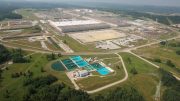The Prospectors and Developers Association of Canada’s (PDAC) 74th annual convention, held in Toronto in early March, provided a striking display of both the renewed vitality of Canada’s junior mining sector and our country’s growing dominance in this field.
The PDAC is a non-profit organization steered by a 48-member volunteer board of directors representing 5,000 members, including 630 corporate members, and its convention this year boasted 430 booths, and official delegations from 35 countries.
Attendance at this largest-ever gathering of Canada’s mineral-exploration community cracked a record 15,000 people, way up from the 12,000 attendees last year, and double the number of just a few years ago.
Even with the crush of people, the same small team of full-time PDAC staffers, numbering less than a dozen, deftly managed to scale up the size of the conference with no significant compromises or setbacks.
Amazingly, roughly 60% of the world’s exploration and mining companies are now turning up in one form or another at the PDAC.
And while conventioneers’ entertainment budgets haven’t quite reached bacchanalian levels, the after-hours activity this year in the nearby hotel suites was decidedly up a few notches in quality, with your harried scribes having to juggle competing mining events boasting celebrity chefs and salsa dancers.
Of course, the power behind all this surface froth remains the strong and still-rising prices of virtually all mineral commodities since 2002 in response to a buoyant global economy, particularly in the U.S., China, India and Brazil. And this industrial demand is butting up against nagging supply constraints and small, but significant, investor demand.
Just in the last year, we’ve witnessed record high prices for copper, coal and iron ore, while gold has traded at its highest level since the early 1980s. Uranium prices have also sprung to life, rising 40% during 2005.
Best of all, the general upward trend in mineral prices shows few signs of subsiding any time soon.
This is good news for Canadian mineral explorers both big and small, who have achieved a dominant position worldwide, as attested to by recently released figures from the PDAC and a survey by the Canadian federal, provincial and territorial governments.
Thanks to its rich mineral endowment, strong mining industry, and sound government policies, Canada itself now ranks as the no. 1 destination in the world for exploration dollars.
The preliminary estimate for mineral exploration, deposit appraisal and mine-complex development spending in Canada in 2005 is $1.3 billion (around 19% of global spending), up 10% from a year earlier. A further 9% rise to $1.4 billion is expected for 2006, roughly triple the level of spending in the dark days around the turn of the millennium.
Last year, most of the rise was due to the sharp upturns in activity in Saskatchewan (for uranium and diamonds) and British Columbia (for coal and copper-gold). Ontario, Manitoba and the Yukon also showed significant boosts.
Gold remains the primary exploration target in Canada, with $514 million spent on the hunt in 2005, and a similar figure is expected this year.
Base metals have risen to second spot among most-favoured targets, with $300 million spent in 2005 and $384 million expected in 2006. As well, uranium exploration expenditures are expected to reach an unprecedented $123 million in 2006, mostly in Saskatchewan.
Spending on the high-stakes game of diamond exploration remains strong in Canada, having levelled off in recent years at a quarter-billion dollars annually. The Northwest Territories, Nunavut and Saskatchewan continue to reign as the most-popular destinations for diamond dollars, followed by Ontario and Quebec.
Where Canada really shines is in its healthy junior sector, which is responsible for 62% of the exploration in Canada and 48% worldwide. In Canada last year, 600 of the 736 active mineral project operators were juniors, and since 2004, exploration spending by juniors has outpaced the seniors.
Benefiting from past generations’ successful and sometimes heroic mineral-exploration efforts, Canada now produces more than 60 mineral commodities from 190 mines, 3,000 quarries and 50 smelters, refineries and steel mills.
In 2004, the country’s mineral production, including coal and oil-sands, was valued at $40 billion, representing 4% of the country’s gross domestic product, 13% of export revenues, 66% of rail freight and 75% of port volume.
And in a world where technological “centres of excellence” are created and carefully nurtured, Toronto has firmly entrenched itself as the global capital of mine finance. Roughly half of the venture capital raised for mineral exploration and mining projects around the world is now raised on either the Toronto Stock Exchange or its Venture Exchange. Some 65% of the world’s mining and mineral exploration companies are now listed on one of these two exchanges.
From their frozen base in the Great White North, there are now some 700 Canadian exploration companies working abroad in 100 countries on 3,500 exploration projects.
With so much momentum building in the industry, next year’s PDAC convention — celebrating a diamond anniversary — is virtually guaranteed to be the biggest yet.



Be the first to comment on "Editorial: Good times, rolling"